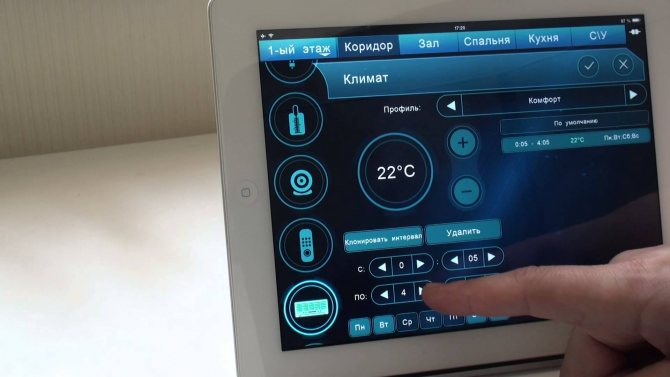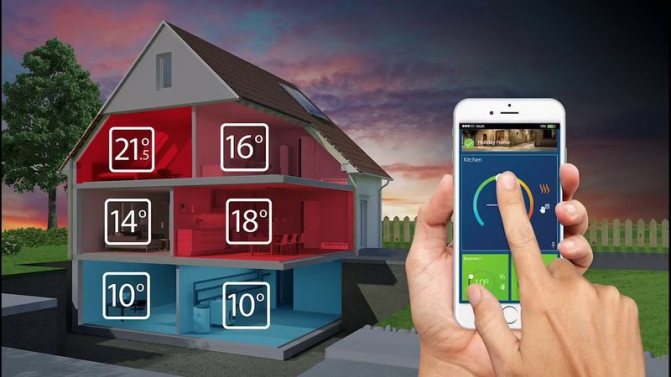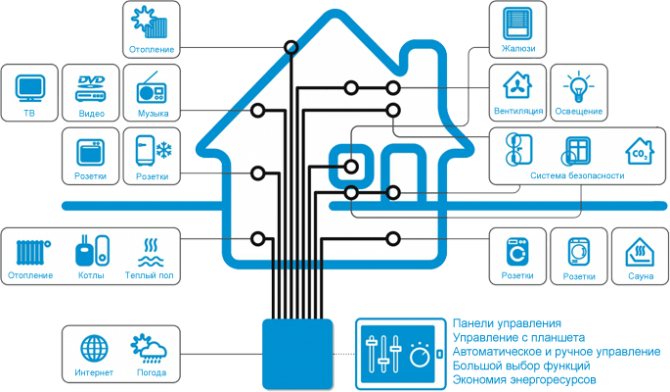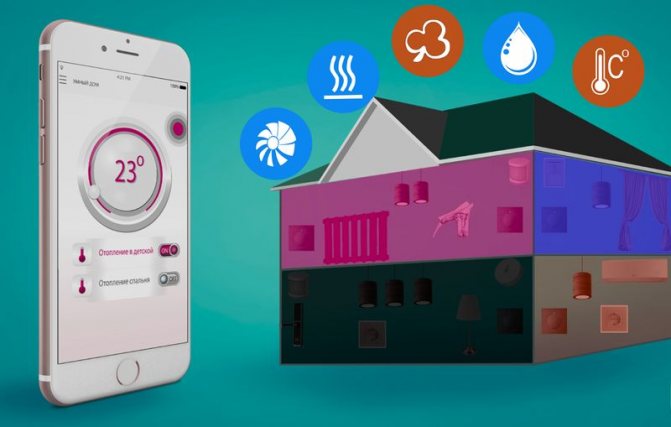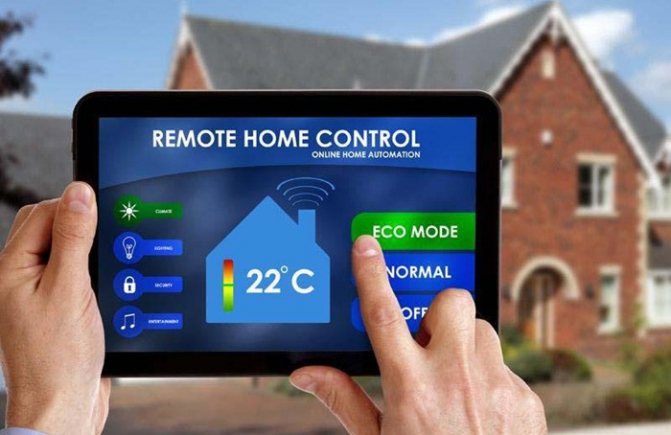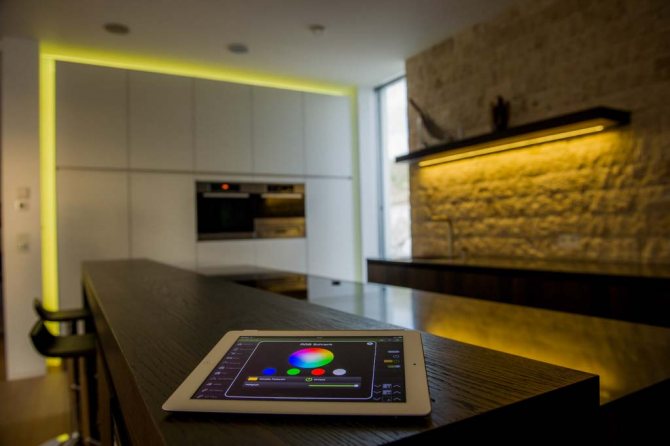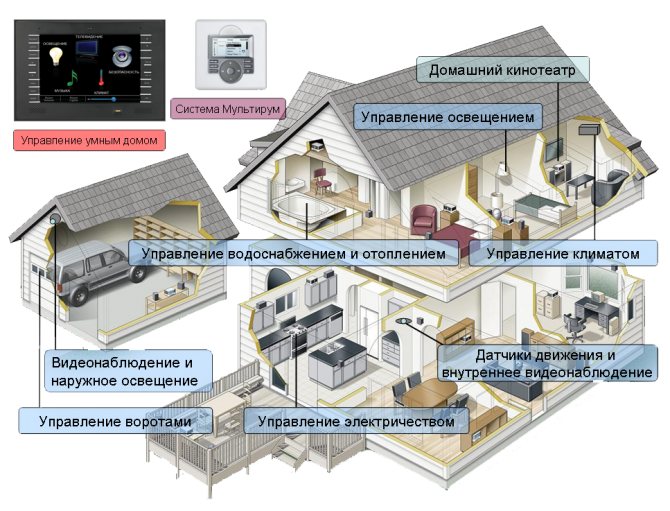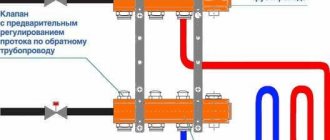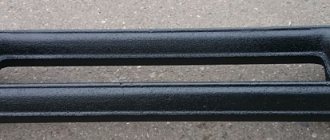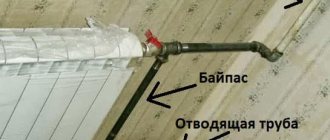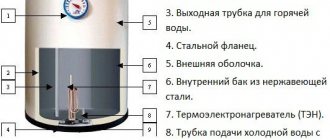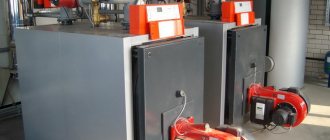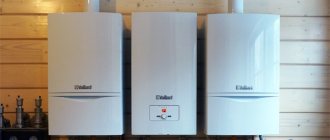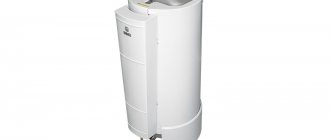We start assembling the system for remote switching on of electrical appliances via the Internet
- Install the free Z-wave Home Mate software on your smartphone or tablet.
It can be downloaded for Apple mobile devices at itunes.apple.com, and for Android devices at play.google.com. For Android tablet owners, the Z-wave Home Mate version is suitable, for smartphone owners - Z-wave Home Mate (Phone).
- Carefully read the instructions for the mobile app, Z-Wave controller and relay.
Instructions in Russian can be downloaded here:
It is more convenient to print these documents in advance so as not to be read from the smartphone screen - you need your mobile device to make settings.
- Connect the Z-Wave controller to your WiFi router.
The procedure is simple. In short, launch the mobile application, scan the QR code on the back of the controller with a smartphone camera and enter the factory password and username specified in the instructions. Then go to the device list screen and click on the controller name. For more details see. And it will help you to cope with the task even faster.
Important! After connecting, be sure to change the factory password of the Z-Wave controller. Password change is a standard security procedure for any smart device connected to the Internet
- Connect the relay to the controller.
To do this, select the “Include device” item in the application: for 60 seconds, the controller will enter the search mode for a new device. Then plug the new relay into a power outlet. The controller will detect it and add it to the network. The relay name will be displayed in the general list of connected devices. Try turning the relay on / off via the app.
Important! When adding a new device for the first time, the controller should be no more than 1 m away from it.After successfully adding to the network, the relay can be connected to any outlet that is no more than 30 m away from the controller
- Connect the heaters to smart relays and try to control them through the app.
Happened? Your system is ready to go! Now, leaving the house to the dacha, just start the program on your smartphone and turn on the heating remotely. In the app, you can program sockets to start and stop automatically at a specified time.
Smart sockets can be used to connect not only heaters, but also other household electrical appliances. And most importantly, the Switching Lite kit will become the foundation of your future smart home. Unlike devices using GSM mobile network and SMS-messages for control, the system based on Z-Wave technology is easy to expand. Just buy sensors for motion, temperature, opening and closing doors and windows, water leaks, alarms, etc. Moreover, you do not have to purchase a SIM card for each module, as required by GSM products. And the convenient and intuitive Z-wave Home Mate app will help you manage your smart home without any extra hassle.
How to ensure heating control in the Smart Home system
If you try to implement a “smart home” heating system with your own hands, positive effects can be achieved without even combining heating systems under the general control of a computer.
Heating elements and heating units can be equipped with controllers associated with indoor temperature sensors. After that, the heating devices can be set to the operating mode (the order of switching on and off by time or when the temperature reaches a certain value).
The disadvantages of this solution are as follows:
- each such device will have to be configured separately;
- he will not coordinate his work with other systems at home;
- each individual system will not react to temperature changes from the outside, since it simply does not have such data.
A more effective solution is to create a space heating system under the control of a single control unit, which can be set to a general operating mode (taking into account the peculiarities of functioning for each group of heating devices separately).
For both simple and combined heating systems, it is a good idea to define the temperature zones by setting separate heating parameters for each of them. A smart home whose heating is configured in this way will heat the living quarters more strongly, give heat to the garage with less activity, and make sure that the temperature in the wine cellar does not rise.
Weather-compensated heating control
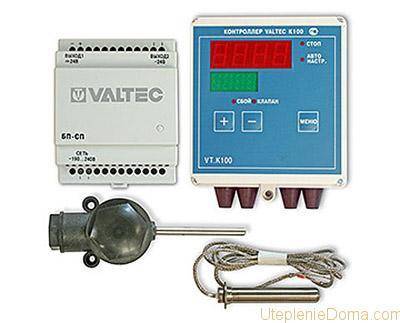
An important link in the "smart home" system is the weather-dependent regulator.
A weather-compensated heating controller is one of the key elements for creating comfort with a smart home. An external temperature sensor allows you to correlate the temperature outside the room and the inside, and then, according to a given curve of this ratio, determine the operating mode without human intervention.
The weather-dependent heating controller will control the heating of the room, responding to changes in the weather outside: evenly increase the temperature when it gets cold, or stop heating if it is hot outside.
Since the weather heating controller reacts to the outside temperature, it can maintain heat according to a preset program and prevent excessive consumption. Smart heating of a country house will lower the temperature when there is no need to heat the premises (if the owners have left).
Integrated heating control in the "Smart Home" system
An integrated approach involves heating control in combination with monitoring the operation of the ventilation system and the water supply system. This allows you to fully maintain a certain climate in the house, taking into account the air humidity and temperature indicators in different rooms.
You can set various operating scenarios for all systems controlled by the "Smart Home", and implement a notification function if any of the subsystems fails.
In addition, you can use mobile communication to give a command to the system. Smart heating of a country house will start preparing living quarters for receiving guests on such a signal in advance.
Integrated management of heating, ventilation, water supply and electricity in the “Smart Home” system as a result gives and increases energy efficiency (the crisis of energy resources dictates solutions in household construction).
Conclusions and useful video on the topic
In the following video, a rather interesting option for introducing automation of the heating system is proposed:
Technology is driving society forward. The level of comfort and convenience is increasing. A striking example of this is the heating system of a private house or apartment, endowed with the functions of full control of the process without human intervention. The user only needs to define the level of comfort in order to obtain the desired microclimate throughout the house and, in addition, substantial savings.
If you have valuable information on arranging heating in a smart home system, please share it with our readers. Leave your comments, ask questions in the block below the article.
Remote control of complex heating systems
The Polish company Tech Controllers is gaining an increasing share in this market segment, producing a wide range of controllers with remote control capabilities.
By themselves, Tech controllers are multifunctional devices that are the main, basic part of the system, which can remotely control almost any complexity of heating systems using additional modules. There are a lot of possibilities, therefore, using an example, we will only consider the possibilities for remote control.
Installation example of Tech Controllers equipment
The photo used for editing:
one.The Tech ST-409n controller is a multifunctional device designed to control a central heating system, providing:
• interaction with three wired room regulators
• interaction with a wireless room thermostat
• smooth control of three mixing valves
• control of the DHW pump
• return temperature protection
• weather-compensated control and weekly programming
• the ability to connect the ST-65 GSM module for remote heating control from a GSM smartphone
• the ability to connect the ST-505 module, which allows remote control of the boiler via the Internet.
• the ability to control two additional valves using additional modules ST-61v4 or ST-431 N
• Ability to control additional equipment such as garage doors, lighting or sprinkler, etc.
Different Tech modules can be used for remote control, depending on the specific needs of the owner. For example:
2. Tech Wi-Fi RS module, which allows:
• remotely control the operation of the boiler via the Internet
• view the parameters of all devices in the heating system
• edit all parameters of the main controller
• view the history of alarms and parameter changes
• assign an unlimited number of passwords (for different access levels - menus, events, statistics)
• change the set temperature on the room regulator
• notify owner of alarms by email
3. Ethernet module Tech ST-505
• remote control of the boiler operation via the Internet
• viewing the parameters of all devices of the heating system
• the ability to edit all parameters of the main controller
• viewing the history of alarms and parameter changes
• the ability to assign an unlimited number of passwords (for different access levels - menus, events, statistics)
• changing the set temperature on the room regulator
• alarm notification by email of alarm
The module interacts with the Tech controller wirelessly and allows remote control of the boiler operation from a GSM mobile phone.
• SMS message about each deviation from the preset boiler operation parameters,
• the module sends on demand a message with information about the current temperature on all active sensors. After entering the authorization code, it is also possible to remotely change the set temperatures.
• by sms and by phone (incoming call) with a message about a malfunction of the heating device.
What if the heating system is so individual that none of the above solutions can fully meet the needs of its owner for its control?
There are no hopeless situations! Most often, the customer himself simply does not understand (and should not!) All the capabilities of modern remote heating control systems. It is really difficult for an unprepared person to understand all this abundance of devices offered on the market, which are completely different from each other in functionality, price, and, of course, quality. And installers, often, simply have no idea about the possibilities for controlling heating systems - their task is to mount the system, but how often you will run around the house (or into the boiler room) and turn various valves to ensure constant thermal comfort, they do not care ... Our specialists more than once had to almost completely redo the "creations" of such craftsmen, and this, believe me, costs a lot of money. Miser pays twice. Contact us, we will advise you for free, and, if necessary, we will install a remote heating control system, we will help with the selection of high-quality equipment at an affordable price.
You will be satisfied working with us!
Remote control of the boiler room using mobile GSM
But what if there is no wired Internet in a country house? How can the heating be controlled in this case?
It's very simple - with the help of a special GSM module and, of course, a mobile phone. In fact, the GSM module plays the role of your personal assistant - you called it, gave the command, for example, to heat it hotter by a certain time in advance - and the whole family will come to a warm and cozy home. Or, on the contrary, you forgot to turn down the boiler power when leaving for work in the morning - no question, you can do this directly from work, via the Internet or directly from your smartphone, while you are still getting to work
The GSM module is a compact device with its own SIM-card of any operator (it is important that it provides reliable signal reception in a given area), which allows you to control the indoor climate from any phone (satellite, mobile or fixed connection), tablet or PC
Depending on the settings made, your phone will receive either short SMS notifications with various information and instructions on changing the settings of the heating boiler, or you will receive phone calls with various information about the operation of the heating system. A special mobile application is installed on the phone (there are versions for Android, and for iOs, and for Windows Phone), which allows you to directly remotely control almost all parameters of the heating boiler.
The GSM heating control module is essentially a computer docked with external sensors and has the ability to change the operating modes of the heating system. Naturally, the module must be in the area of reliable reception of mobile operators.
GSM module for heating boiler GSM-Climate ZONT H-1 - a very interesting solution is offered by the Russian company Micro Line, which specially manufactured this device for the company Evan, which produces heating boilers. Immediately, we note that Zont H-1 GSM is suitable not only for Evan boilers, but, in fact, for any heat generators that have appropriate terminals for connecting a room thermostat!
GSM modules in their work, as a rule, use cloud services, so you will always have the opportunity to control or change the parameters of the heating system via the Internet (that is, without sending control SMS or phone calls) using a tablet, personal computer or smartphone, by going to the website of the module manufacturer using your username and password.
GSM heating control module can operate in several modes:
- automatic, when, according to signals from the installed sensors, the controller maintains the specified modes according to the specified program;
- SMS heating control, when the heating system is controlled by sending SMS. In this case, when new data arrives, for example, about the room temperature, the controller accepts them for execution and begins to support them in automatic mode;
- warning, by sending alarm messages about the current state of the house (gas leak, breakthrough of the water supply system, etc.);
- remote control of other devices connected to the GSM module (watering, lighting, alarm, etc.).
GSM - heating control allows remotely:
- receive reports on the room temperature;
- receive notifications about the current state of heating equipment;
- change the operating mode of the system by raising or lowering the temperature, including separately in each room.
Heating control is not limited to these functions. In principle, any heating system can be turned into a remote one. To do this, it must have an automatic mode of operation, and a special GSM controller must be connected to it for heating control and communication with the subscriber.
Energy saving
Heating control allows to achieve energy savings of 20-30%.
Energy resources are steadily becoming more expensive and in the long term for the life of a house (up to 50 years), the cost of heating a house is quite large and exceeds the cost of the heating system itself, which is easy to check.
A simple example from life (2017th year, even without taking into account the rise in energy prices):
- A private house 45 sq.m. with a double-circuit heating boiler,
- It was spent on heating equipment 150000 rub.,
- Annual gas costs = 8100 rub.,
- Annual electricity costs for the boiler pump = 1314 rub.,
- Total expenses for the year: 9414 RUR,
- In the long term, home life for 40 years = 376560 RUR.
- As a result, energy costs exceed the cost of the heating system more than TWO times.
This means that the benefits achieved through heating control translate into a significant amount.
Energy saving by 20-30% is achieved due to:
- Maintaining the required temperature in the premises, which eliminates the need, for example, to open the vents if it gets hot.
- Maintaining a low temperature in technical rooms: garage, storage room,
- A general decrease in temperature in the house by 3-5 degrees in the absence of owners (weekends, vacations, etc.)
- Special climate control methods such as proportional control.
Of course, for owners of apartments with general heating, this is not decisive, since the costs are divided among all residents by the area of the room. But with gradual mass adoption, as in Europe, it also becomes relevant.
Heating control system elements
The heating control unit is a collection of elements combined into a single circuit. Their selection becomes key to ensure the efficiency of the system. Items may differ in characteristics. The main indicator of their effectiveness is the possibility of forming a multilateral communication between the control unit, the owner and the heating elements.
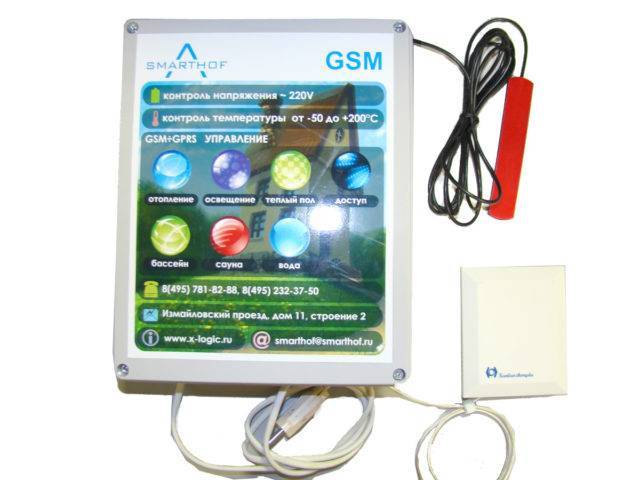

The basis of the system is a special electronic unit with 1 or more slots (slots) for installing ordinary SIM - cards of cellular communication
Typical complete set of elements of the GSM coordination system with heating:
- connecting wires;
- several temperature meters;
- GSM controller;
- leak detector;
- electronic key scanner;
- access control mechanism;
- antenna for reception and transmission of GSM signal;
- accumulator battery;
- ethernet adapter that provides interaction with other elements;
- pads for connecting to the boiler;
What are the capabilities of remote heating control systems
- normal operation, when the set temperature is maintained throughout the house;
- zone mode, when in different rooms there can be an individual temperature;
- prevention of defrosting of the heating system (freezing of pipes) during the cold season, when you are away from your country house or summer cottage;
- the possibility of turning on the boiler in advance, for example, you need to warm up a country house when you are going to visit it on weekends or holidays;
- always be aware of the operation of your autonomous heating and, if necessary, carry out its diagnostics;
- time mode, in which at different times during the day in the house its own thermal mode can be maintained with a significant reduction in material costs for fuel, for example, you can adjust the boiler to low power (respectively, to low fuel consumption), going to work or on business, and turn on normal mode before returning.
Remote heating control implies that any of these modes, as well as specific temperature values in rooms, are changed using a mobile connection, or heating is controlled via the Internet. This approach is part of the ideology of creating a “smart home”, which entails the further development of all engineering systems of the house in order to ensure ease of use and the creation of the most comfortable living conditions.
Which heating system can be remotely controlled?
In country houses and cottages, two-pipe systems with forced circulation of the coolant are currently most often used: the circulation pump pumps the coolant throughout the heating system, which, thanks to the distributor comb, can be supplied to each heating device. In such systems, as a rule, a safety block is used heating system to protect it from destruction in unforeseen situations, for example, in the event of an increase in pressure above the permissible level. It is also necessary to have additional equipment to control the operation of the heating system: sensors, special valves and devices for regulating the flow of the coolant, and it is also necessary to combine various devices into an information net
Heating system in a smart home smart boiler and not only
The air temperature in the house depends on the efficient operation of heating devices, the heat transfer of which should compensate for the heat losses of the building, the level may vary depending on weather conditions: wind speed, humidity, time of day.
A simple relationship arises: the higher the heat losses (or, the worse the weather), the greater the heat transfer must be provided by the heating devices and the more heat must be generated by the heating boiler.
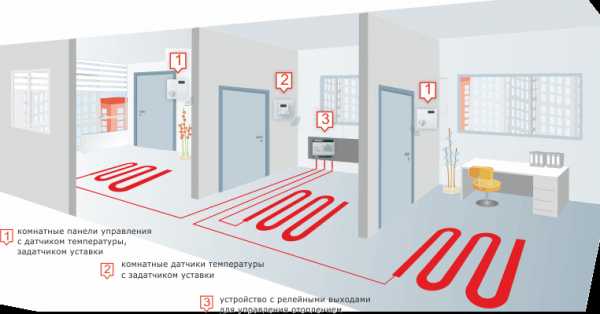

The boiler can be operated manually by increasing or decreasing the fuel supply to the combustion chamber. But, you must admit, it is better if the heating boiler can itself determine how much heat it needs to generate and how much fuel it needs to burn for this.
The automatic control system is the first step towards a smart boiler
Modern heating boilers in Smart homes are equipped with automatic control systems capable of adjusting the intensity of fuel combustion depending on the real need for heat energy.
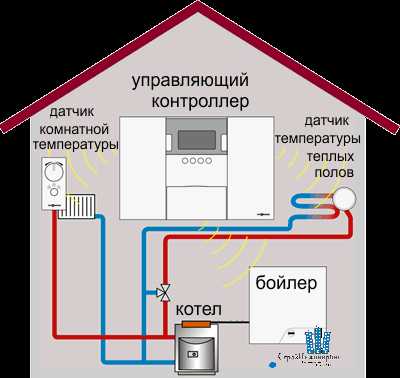

However, the response to changes in the weather conditions of a conventional boiler can be delayed by several hours, depending on the degree of inertia of the heating system. The fact is that the automatic control system of heating boilers (let's call them conventional, in contrast to "smart" heating boilers) is overwhelmingly configured to change the temperature of the water in the return: the water in the return pipe has cooled down stronger, the fuel supply to the combustion chamber increases, the temperature the return flow is higher, the fuel supply to the combustion chamber is reduced.
In turn, the coolant cools down the faster, the lower the air temperature in the heated room.
Another important detail: a quick response of the boiler to a change in air temperature is possible only when using heating devices with a small internal volume, for example, aluminum or bimetallic radiators.
Video - Bitherm boiler with a movable grate and smart control unit
Smart heating boiler
The smart boiler is controlled by a thermostat with a temperature sensor installed in one of the rooms. The principle of operation is extremely simple: using a thermostat, the desired temperature is set, upon reaching which the boiler turns off. When the temperature drops, the boiler is put into operation, and the process is repeated again.
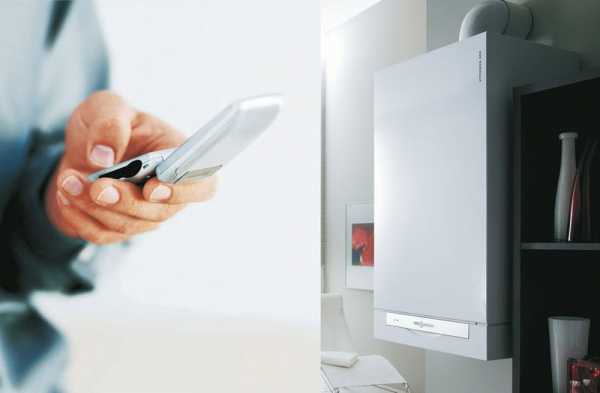

By placing the temperature sensor outside, it is possible to set up the boiler operation "in advance": the outside air temperature has dropped, the boiler operates in a more intensive mode.
The timer in the operation of a smart boiler is designed to select modes of intensive and moderate operation. So, for example, at night a slightly lower temperature is more comfortable, by about 2-3 degrees compared to the daytime temperature. In this case, you can turn off the heating of water in the boiler at night. Moderate operation of the boiler can be programmed during the daytime, when all the inhabitants of the house are at work. Boiler operating modes can be set during the day, during the week, month and even year.
For this, the smart boiler is equipped with a self-diagnosis system.
Boiler self-diagnosis system
The boiler self-diagnosis system allows you to determine from 10 to 40 (depending on the boiler model) malfunctions, a number of which can be eliminated in automatic mode. Information about the detected malfunctions is displayed on the display and stored in the device's memory.
All this makes the operation of smart boilers not only convenient, but also safe, excluding the possibility of emergency situations, such as a decrease in the temperature of the coolant below a critical mark, a decrease in draft, a drop in pressure in the gas pipeline network and a number of other equally dangerous situations that are not excluded during the operation of the boiler. ...
Smart home - smart heating
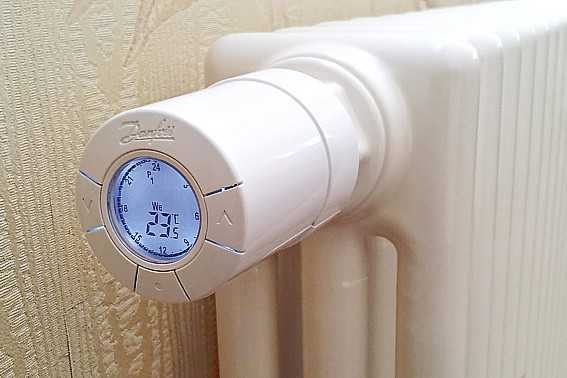

No matter how efficiently the boiler works, to ensure truly comfortable conditions in the house, controlled heating devices are needed that can respond to changes in room temperature. For this, radiators are installed in the heating system, equipped with thermostats and servo drives that change the flow rate of the coolant depending on the ambient temperature.
Let's summarize
The heating system of a smart home can be based on a heating boiler equipped with a self-diagnosis system and weather-dependent automation, the operation of which is effective only together with radiators equipped with thermostats and servo drives.
umniedoma.ru
Comments.
| Andrey 03/12/12 93 it is necessary to control heating elements with a capacity of 3 kW. tell me how to connect triacs to BM8036 through standard outputs. |
| Egor 03/12/12 95 Download the instruction, the link to which is at the very beginning of the article, this instruction shows all the necessary schemes. Do not forget the fact that triacs with such a power must be installed on radiators. |
| Andrey 03/12/12 96 I cannot understand this instruction. the instructions say: For BM8036, which has no triacs on the board, you need to connect power triacs to the XS5-XS12 outputs. in Appendix 1 BM8036: The electrical circuit of the triacs is. but in Appendix 2 NB8036 they are just not there. |
| Egor 03/12/12 97 So you have NM8036 or BM8036? Appendix 1 is BM8036 and Appendix 2 is NM8036. Their output stages are obviously different. What do you have in the output stages? Check the specification if the board is not clear. How many channels? |
| Andrey 12.03.12 98 I plan to buy BM8036. while I understand everything. do you have triacs in the output stages in the NB8036? the instructions say that there are no triacs on the BM8036 board, although they are on the diagram. this is what misleads me. |
| Egor 12.03.12 99 Yes, there is apparently a mistake in the instructions. You should read: "For NM8036, which has no triacs on the board ...". NM really does not have them either in the circuit or on the board. As far as BM is concerned, I do not presume to judge what is there and what is not. I am working with the NM8036 Timer-Thermostat. |
| Evgeniy 03/29/12 146 Good afternoon !!! I can't figure out how to connect the NM4411 to the NM8036, what should I connect to? |
| Egor 03/29/12 147 The article shows the controller contacts to which the load channels are connected (to enlarge, click on the picture). These pins must be connected to the NM4411 inputs. Each NM4411 has 4 load channels, respectively: 4 inputs. I am using all 12 channels of the controller, so I have 3 NM4411 units. |
| Eugene 03/29/12 148 NM4411 has contact X6 - common or ground, and with NM8036, which contact to take for the bundle? It's just that I'm very far from radio engineering and even more so from reading circuits !!! Thank you very much for the clear answers !!! |
| Egor 03/29/12 149 Common, ground, minus the power supply, GND - all this is the same wire. My common NM4411 is connected to the minus of the power supply, because it is the same for all consumers. |
| Evgeniy 03/29/12 150 Thank you very much !!! |
| Dmitry 02/04/14 626 Could you give a layout of the printed circuit board that you have under the NM8036 to display all 12 control channels |
| Egor 02/04/14 627 Board drawing https://www.goandsee.ru/_files/plata.jpg Board size 140 x 96 mm. |
| Dmitry 02/04/14 629 Thank you very much |
Pros and cons of heating control system Smart home
Heating control using a smart home allows you to achieve the following:
- the climate in the house or in any chosen room will exactly correspond to the owner's feeling of comfort, in accordance with the program of operation of the heating devices chosen by him;
- automated control of the heating system can significantly reduce energy consumption;
- intelligent control of household subsystems at home will allow them to be monitored remotely and not worry about possible breakdowns (the computer will react to a malfunction).
The disadvantage of such technologies is still availability due to the rather high cost of equipment and installation of the system.
Spending a couple of weekends in the winter at the dacha - what could be better if you want to take a break from the city noise and crowds? And to come to a country house, warmed up in advance to a comfortable temperature, and even more so.
We have already written about why it is advantageous to use a starter for remote heating of a summer cottage with control via a smartphone or tablet. Now let's talk about how to install it yourself. Don't worry: you don't need the help of an electrician, no installation tools, no wires, or special technical knowledge. If you can program, say, a microwave oven with a snooze timer, then you can easily cope with the installation of the Switching Lite kit.
Electric heaters up to 3 kW can be connected to the included smart plug-on relay. They are quite enough to warm up the rooms of a medium-sized country house in two to three hours. Are you ready to try it? Begin!
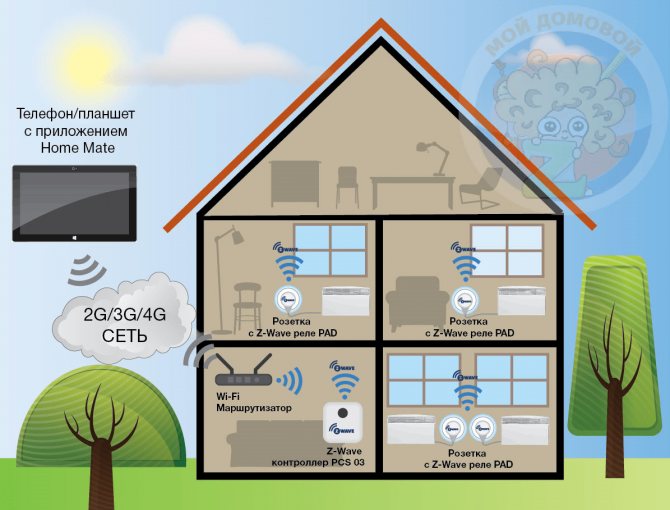

Control scheme for heating devices via the Internet in a country house
Smart House
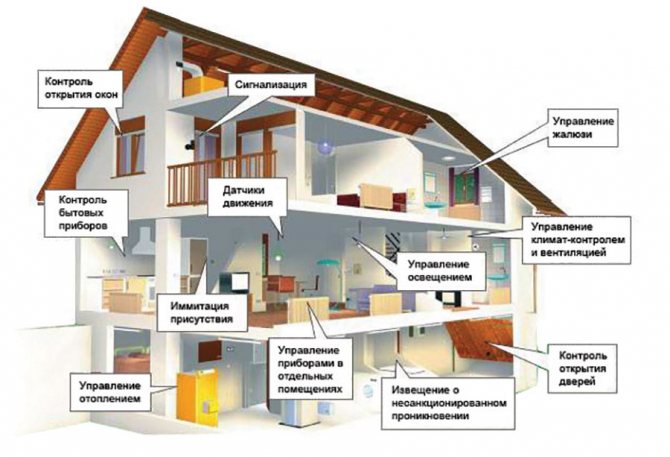

A comfortable temperature and coziness in the house are important components of the well-being of the household. Constant dampness or, conversely, air dried out by radiators can cause discomfort and even cause various diseases. To maintain an optimal climate, it is not always enough to simply turn on an additional heater, since the heating of the premises is likely to be uneven and the air will be dry.
A smart heating system for houses and apartments only at first glance seems like an unnecessary luxury, fun for the rich. In fact, it is precisely the correctly selected automated complex that is able to save the family's budget, while adapting the temperature and humidity in the room to the most comfortable conditions.
general information
A modern smart heating system presents a whole range of possibilities combined in a single complex. After setting, it ensures the implementation of independent control not only for heating in the premises, but also for ventilation in the house, water supply. As in any intelligent systems, all actions are performed remotely using a smartphone or tablet.
"Smart" heating is much more efficient and more economical than any standard heating systems. The “Smart house” system can be programmed in such a way that in each room of the dwelling its own temperature and humidity regime are constantly maintained. After all, it is possible that you will want to warm up the nursery, bedroom and living room well, but you can leave it cooler in the kitchen, dressing room and hallway.
In addition, it is possible to automatically reduce heating at night when slightly lower temperatures are comfortable for healthy, prolonged sleep.
In a smart home, you don't have to pay for heating while you are away. While you are at work, in a shopping center or visiting, the heating system will operate in an energy-saving mode, lowering the temperature, and will prepare a comfortable environment directly for your arrival. All that is required for this is to send her a message using the phone.
A wide range of such systems is presented on the modern smart-equipment market, and in different price categories.You can purchase a whole complex or separate "smart" gadgets, which will allow you to find a compromise in the price-quality ratio.
With the smart home system already installed, almost all new heating models can be intelligently integrated into the main control module.
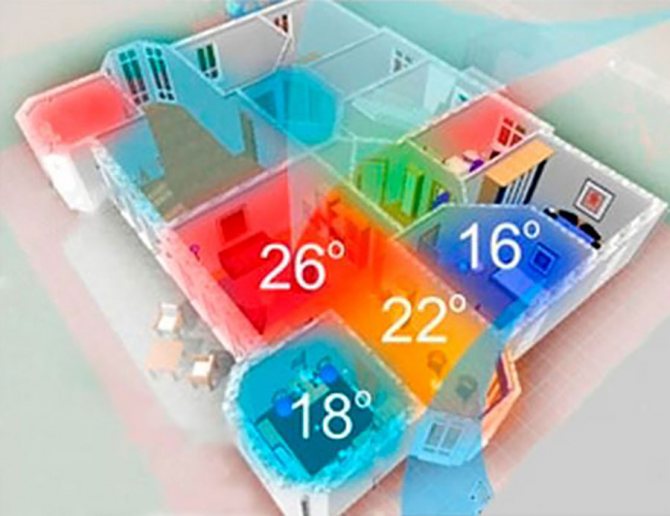

Smart heating in detail
Smart heating offers a wide range of possibilities: from controlled radiators to warm walls that heat the air in the room during the cold season, and take care of the coolness in the heat. Underfloor heating, intelligent convectors and much more can also be referred to as "smart" heating gadgets in the house. All devices of this system are able to independently change the room temperature to achieve maximum comfort.
The central control system is a general computer to which all appliances and gadgets in the house are connected, including indoor and outdoor temperature sensors.
The user himself initially sets the indicators of a comfortable temperature for him in the settings of the general computer of the heating system. The system summarizes the data that comes from the working sensors. When a temperature discrepancy is detected with the set parameters in the program, the smart system is activated and gives the command to adjust the operation of the air heating elements to achieve the optimal temperature in the room.
When installing such a system in a home, you always need to take into account a number of factors. Often times, you can specify the general characteristics of your home in the settings. Then the computer will decide exactly how to regulate the heat in the house or apartment, starting from the given indicators. Room temperature can be affected by:
- room humidity percentage;
- the quality of the material of the windows and the quality of their installation;
- the level of thermal insulation of the room;
- drafts;
- type of selected heating system.
When setting up "smart drowning", you should take into account the whole picture, the analysis of which will allow you to see the shortcomings and their causes. Otherwise, you will greatly lose in the quality of her work. In case of violation of the insulation of the room, with constant heat leakage through the cracks, the system will actively work at maximum, trying to maintain and maintain the specified climate. Of course, the automated heating system will cope with the task, but for this it will have to spend additional energy resources, which will significantly affect the price tag of utility bills at the end of the month.
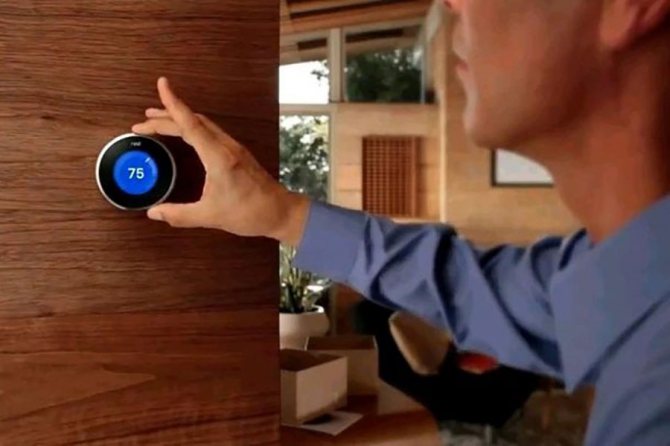

Varieties of smart heating systems
There are several options for heating automation. These can be either separate smart gadgets that can be mounted independently, following the instructions, or serious systems in conjunction with a gas or electric boiler.
The first option is perfect for an apartment or a small house with already installed heating. This complex usually includes a thermostat, which is mounted in the center of the room. It measures and analyzes the temperature, after which it sends a signal to regulate the heat supply to the radiator. The radio thermostat built into the mechanical valve can be proportional or two-position. The first provides a smooth change in air temperature to temperature, while the power of the heating elements is regulated depending on the difference between the actual temperature and the set one. The two-position one works at a different pace depending on the changes in the room climate.
A complete boiler system acts as a heat exchange generator. To regulate the heat supply, a heating control module is installed, which analyzes the temperature both indoors and outdoors. Based on the received data, it controls the gas flow to the burner. The boiler room is controlled by using weather-dependent automation, which sensitively monitors changes in the external environment.
Weather-dependent automation is one of the key elements of a high-quality smart heating system.The external sensor correlates the temperature outside the room and the inside one, after which it independently sets up the operating mode.
The regulator controls space heating, instantly responding to temperature changes outside the room. This allows you to evenly increase the temperature in the cold season or stop heating during a thaw outside.
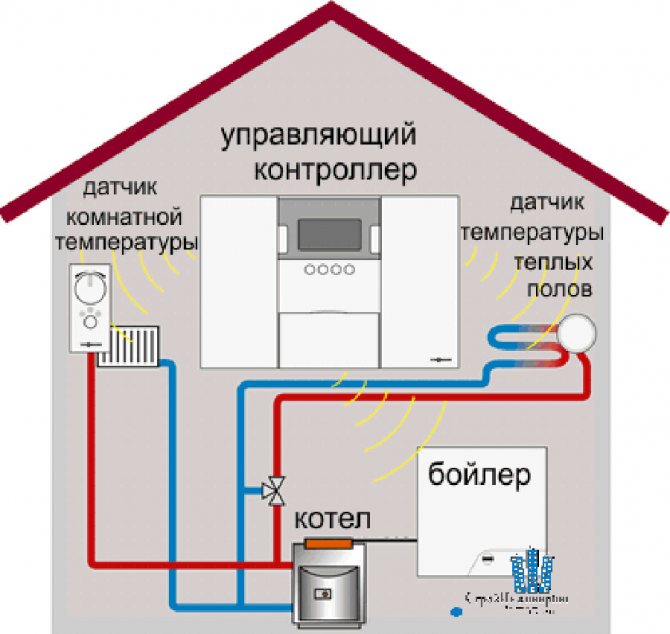

Automated heating system operation
All existing smart heating systems can be divided according to the principle of their operation. As a rule, there are four types:
- wired systems;
- working on a radio channel;
- centralized;
- decentralized.
In order to determine which of the above systems is suitable for your house or apartment, it is worthwhile to understand in detail the specifics of each of them. So, in a wired smart heating system, all sensors, sensors, actuators and other equipment are connected with a special cable. The main advantage of such a system is its highest reliability. The signals from the sensors are seamlessly transferred to the general controller, providing all the information collected. With such a transfer, there are no hindrances and delays in the issuance of the command to its performer. Signals are transmitted quickly, which makes it easy to operate smart home systems.
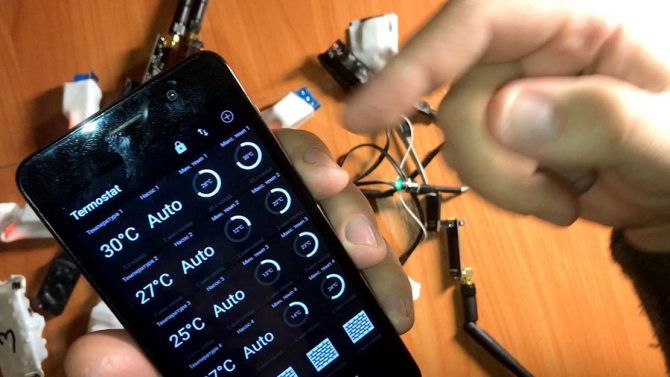

Wired smart home systems and heating
Wired systems are multifunctional and allow you to integrate any external devices into the circuit. You can easily connect a wired "smart home" to climatic and heating equipment.
Long service life is combined with ease of maintenance. Smart equipment connected via a single cable does not need additional power supplies. Also, there is no need to replace batteries and rechargeable device, which contributes to simple and long-term maintenance of devices.
The disadvantage of the wired “smart home” system lies in a rather complicated and time-consuming installation at the initial stage. Concealed cable installation requires complete dismantling of walls and floors. Therefore, the installation of such a heating system will be reasonable if you are planning a major overhaul or are just building a house. It will be almost impossible to install such a system in an apartment with a new renovation or in a turnkey built house with all communications.
When installing a wired system, it is necessary to think in advance about the places where switches and sockets will be installed. Therefore, it is initially important to correctly draw up an installation project for the optimal installation of such a heating system. Most often, this requires a specialist who has the skills to form a heating automation project, install and configure it. Do not forget that at the end you will need to install, connect and rebuild the central control module for the entire system.
Such a global project will require a significant budget, time and effort to implement it. Self-installation of a wired system without knowledge of an electrician is not permissible.
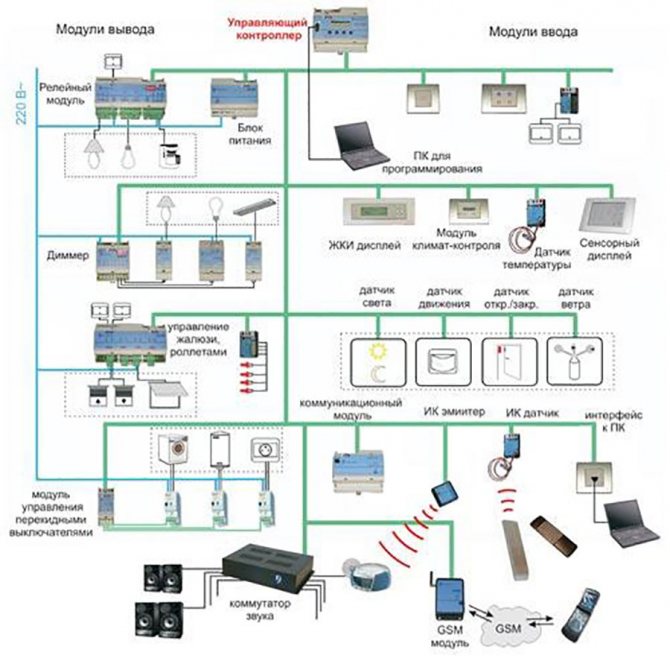

Wireless smart heating system
In the wireless smart home system, all devices connected to the system communicate with each other via a radio channel. Over-the-air connection minimizes wiring while maintaining wall integrity and overall building design.
The installation of such a system does not require the preparation of a unique installation project; it is enough just to outline the places where it is planned to install the sensors, sensors and actuators. This feature significantly reduces the cost of such an installation. It is noteworthy that such systems dominate in the modern market of smart gadgets for the home.
A simple setup methodology and comfortable intuitive work with the interface will allow you to freely use the system even for those who experience some difficulties in communicating with the equipment.
However, in addition to many advantages, wireless home heating automation systems have a number of disadvantages. Among them, we note the need for mandatory control of the energy level in batteries and / or accumulators supplying independent sensors and actuators. And if you can adapt to the need for regular battery replacement and timely battery charging, the lack of security of signal transmission can significantly degrade the quality of automation. Since the exchange of information occurs over a radio channel, sometimes communication can be lost or distorted by interference. In this case, the installation of a special mains filter can help, which will control and filter high-frequency impulses.
The limited functionality of the wireless system can also scare off the active user of "smart" gadgets. Models operating via radio in standard models are limited by features such as lighting, alarms and climate control systems. It is possible that these functions will be enough for many consumers, so we will not over-exaggerate.
So, wireless smart heating systems are the most popular today. Today, world-famous companies are engaged in the production of such intelligent complexes: Xiaomi, Redmon, Broadlink Zamel, HDL and some others.
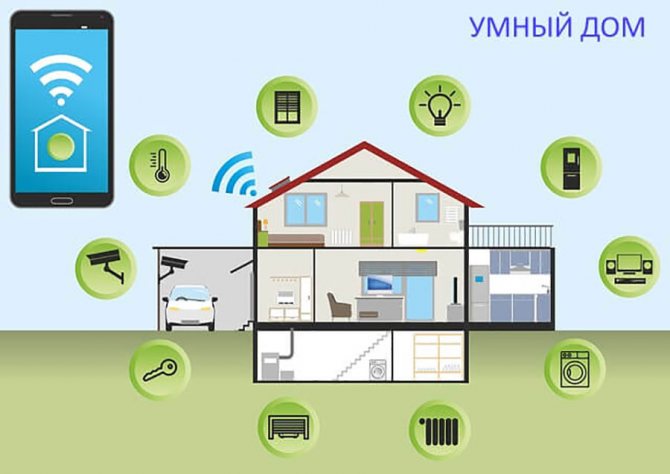

Centralized smart heating system
The centralized system is a combination of wired and wireless “smart-home” systems, in which the devices are controlled through the general controller. In fact, it is a small computer with connectors for connecting external devices. The general computer collects signals from all external gadgets, analyzes the received signals, and sends commands to the actuators.
The advantages of such models include the ease of managing all subsystems of the house connected to a single control center. To activate the system, you just need to set the script to the controller.
As we have already noted, such smart systems are compatible with a wide range of different functional gadgets and devices. Among the shortcomings, we note the low reliability and high cost. If the central control unit fails, the entire system stops working.
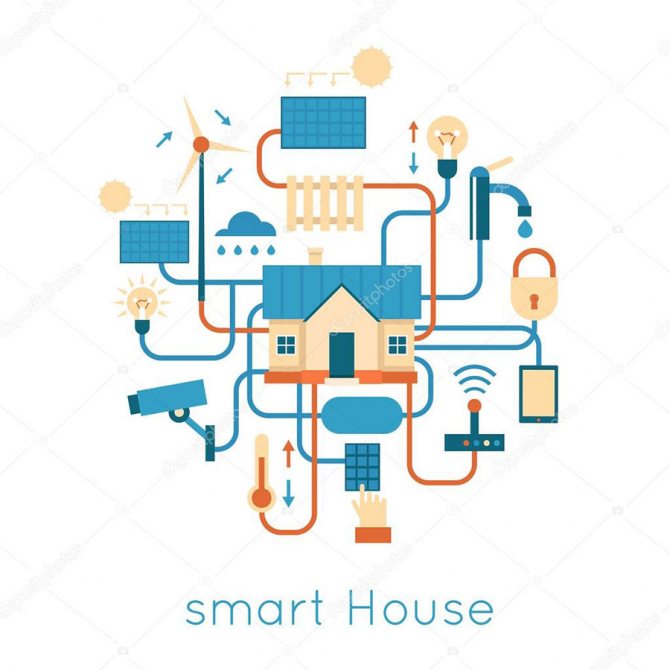

Decentralized smart- heating system
The decentralized model is the opposite of the centralized scheme. Here, each device is equipped with a processor, memory and power source. Hence follows the main advantage of a decentralized smart system - the highest possible reliability. In the event of a disconnection of one or more devices, the rest will continue their autonomous work.
The KNX protocol that this model uses is one of the most understood and demanded in the whole world. If necessary, you can attach an additional unit that is responsible for solving non-standard situations.
The only drawback is the complexity of configuring each module and gadget connected to a single grid. After all, each sensor and actuator has its own personal "intelligence".


Installation
When connecting a smart system, it is quite possible to follow the detailed instructions and install everything with your own hands. However, this approach can lead to inconsistent operation of gadgets.
Leading manufacturers of smart heating systems strongly recommend, for high-quality operation of equipment, to involve in the installation and configuration specialists who have the appropriate software qualifications and experience.
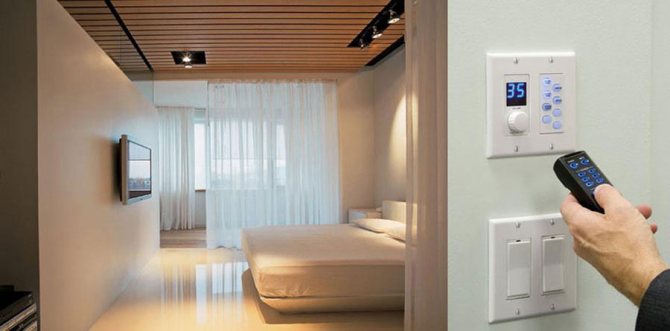

In conclusion
The smart home heating system is able to maintain a favorable climate in the house or apartment, starting from the parameters set by the user. Intelligent home heating control increases the ability to control all familiar household processes, conserving resources and minimizing utility costs.
smart House
Heating controller selection
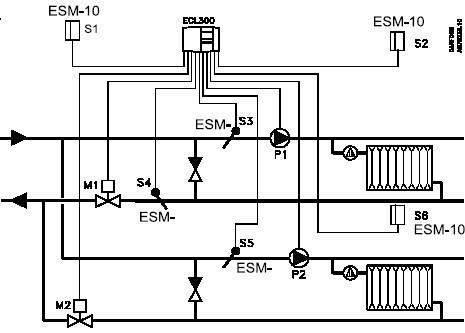

Example of controller wiring diagram
When do you need to install a heating controller? First of all, this device is necessary in case of frequent absences from the house or apartment of residents. By connecting the electronic unit to external temperature sensors (outdoors and indoors) and the boiler control terminals, you can use the built-in software to set up an automatic change in the intensity of the burner operation.
How to choose the optimal controllers for heating systems? The easiest option is to consult a specialist. But it is difficult to find one at this time, as this product is relatively new. Therefore, it is recommended that you first independently study the main selection parameters:
- When comparing a controller for a heating boiler, make sure that the installed equipment has the ability to connect to the control unit. Most often, the boiler is characterized by one-stage or two-stage external control. This applies only to gas models - matching with solid fuel is impossible;
- The number of components to manage. For a Honeywell heating controller, this value can be up to 15, depending on the specific model;
- The presence of a GPS unit. As mentioned above - this function makes it possible to remotely control the heating;
- Frequency of software updates. The modern controller of heating and hot water supply systems TRM 32 can be connected directly to the computer. You can always find the latest software version on the manufacturer's website.
An additional function is to regulate the operation of the components according to the set heating schedule. This possibility is provided in the Aries heating controller.
You should also pay attention to the accuracy of the measurements. In professional models, this indicator should not exceed ± 0.01 of the scale
Lawn Automation Applications
The lawn is a beautiful green carpet, but all its benefits are only possible through our efforts. Mowing, watering, re-seeding, rolling, soil formation, heating ... only because of these processes, the lawn remains in a consistently high-quality form.
So, the lawn requires systematic watering. It can be provided from a regular hose or diffuser, but only at the time of being at the cottage. What to do if it's hot and sunny all week, and you arrive at the dacha only by the weekend. There is a way out - an intelligent irrigation system will help, which, either according to a pre-established program, or depending on the temperature outside, will include watering the lawn.
The problem with irrigation has been solved, but what about green spaces in the fall, for example, if we want to see greenery, and not the first snow? Here we will be helped by heating the lawn, which will prevent snow from accumulating on the soil surface.
The iT500 is lacking No problem Salus iT600 can do anything and more
If you lack the functionality of the iT500 to control only two heating zones, then our website presents a more functional multi-zone (there are wired and wireless versions) Salus iT 600 Smart Home system. Well, something, and its capabilities for remote control of heating (and not only!) Will be enough for even the most demanding consumer!
iT 600 Smart Home combines the ability to control warm water floors, remote control of heating using thermostats, single switching at the “smart home system” level, changing the temperature in each room using a smartphone with Internet access, control and management of any electrical devices in home, connecting sensors for opening windows and doors and many other functionalities. The system far outstripped not only its competitors in the field of remote heating control, but also set the trend in the field of automation and dispatching of engineering systems for many years to come!
Attention! The new Salus iT600 Smart Home product line is already on sale!
Now you can not only remotely control the heating, but also guard the house and control electrical appliances!
Buy heating control system SALUS iT600
Now you have the opportunity to buy Salus iT600 Smart Home - a new line of automation for the Smart Home!
This is the same full-fledged system for remote heating control via the iT600 Internet plus additional features:
- application of the universal Internet gateway Smart Home UGE600, which now supports up to 100 wireless devices of the ZigBee network and is used to replace last year's version of the Salus G30 gateway.
- control and management of various electrical appliances. connected to smart sockets Salus SPE600 with the ability to meter the consumed electricity
- connection and control of security alarms using wireless sensors for opening doors or windows Salus OS600 Door Sensor
- managing your system is now even more convenient. thanks to the new Salus Smart Home app for smartphones on iOS and Android, the interface and registration of devices have become much easier and more intuitive!
All system components are wireless devices operating in the modern ZigBee home network standard, now you can create separate groups of devices working in one bundle and to which you can assign individual tasks.
In the future, the company's engineers intend to expand the capabilities of the smart home control system, but now you can buy Salus iT600 Smart Home, starting with the bare essentials, and build your Smart home at a very attractive price!
And what about the owners of outdated heating systems?
Tech WiFi 8S is one of the newest and most functional models of thermostats from the Polish company Tech Controllers (Polish version of the name Tech Sterowniki), on the basis of which you can build a multi-zone radiator heating control system for your home. For example, in a country house or in a country house, the heating system was installed many years ago. Naturally, a distributor comb was not provided, there are no three-way mixing valves, there is, in principle, no possibility to control something. Until recently, the only way out of this situation was to install mechanical thermal heads on radiators. Such a solution has the right to exist, but, firstly, the accuracy of temperature control is several degrees, and secondly, you need to adjust these very thermal heads on each radiator separately, in the morning and in the evening. Troubled and uncomfortable. Fortunately, electric thermal heads with high measurement accuracy have appeared on the market. Tech Controllers has gone even further and offers you a whole system that controls battery-powered thermoelectric servos over your home Wi-Fi network in accordance with preset settings. And now even the owners of outdated heating systems have an opportunity for a comfortable stay!
Tech WiFi 8S can control the temperature in 8 rooms, each of which can have up to 6 thermal actuators! In addition to controlling thermoelectric drives, the controller can also control the boiler: when the set temperature in all rooms is reached, it will turn off the boiler using a "dry contact".
Buy heating control system TECH WiFi-8S
Benefits
"Smart home" has a number of positive qualities with one drawback in the form of its cost. Among the advantages are comfort and energy saving. Thanks to the system that controls almost all devices and devices at home, staying in it becomes as comfortable and cozy as possible. At the same time, the cost of caring for it is reduced, since the systems choose the optimal work program based on their analysis and calculations. Heating and air conditioning of the Smart Home is programmed in such a way as to minimize the cost of their use.
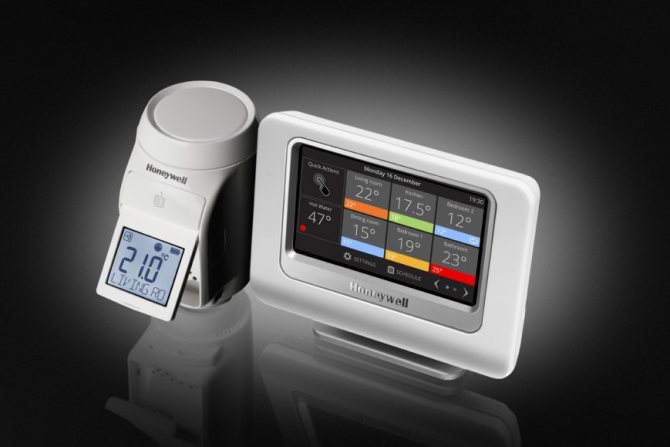

The energy-saving effect is felt from the first days of using the system, since the meter readings drop significantly. The heating season with the Smart Home system will be twice as cheap as without it. Besides heating, ventilation and air conditioning also play an important role in influencing this factor.
How is the heating system Smart home
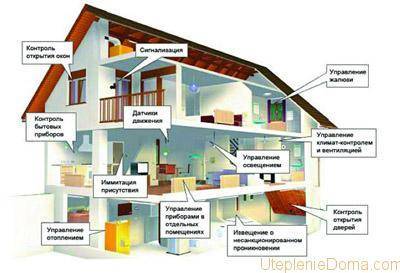

An approximate diagram of the "smart home" system
The thermal conductivity of walls and ceilings, the quality of the windows, the presence of drafts and air humidity, the type of heating system and the way heat is supplied all affect the indoor climate.
Modern heating systems can be functionally different: these are classic radiators, warm floors, etc. In country houses, individual boilers are installed for heating and providing hot water, while a boiler can be used in an apartment.
All this can be controlled by a single system, which is called "smart home". It is a control computer unit associated with home appliances and indoor and outdoor temperature sensor systems. In accordance with the information of the sensors and the set mode, such a system is capable of lowering or increasing the temperature in the room. In addition, it can regulate the amount of hot water ready for use in the boiler.
Features of arrangement of "smart" heating
The most important thing that can be attributed to recommendations for arranging thermal systems in a smart home is the use of high-quality control equipment, as well as reliable filters.
Effective filtration of the coolant flow and the use of reliable control mechanisms contribute to the accurate and flawless operation of the system.
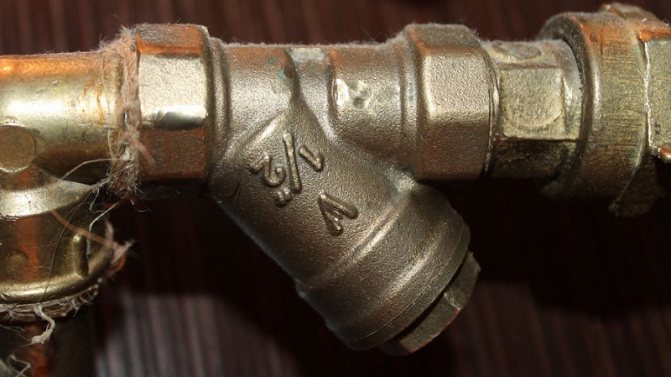

Even the most automated system cannot function normally without the presence of a familiar and simple element - a filter. This point should be taken into account when dealing with the solution of the automation problem.
Automated modules based on controllers provide a high degree of sensitivity, allow you to regulate processes with an accuracy of one percent.
However, in the absence of filter modules, the operation of the flow regulators can be disrupted after a short time of operation.
It is recommended to technically competently calculate and select the installation points for thermostats (sensors, sensors), since a correctly selected installation site allows you to achieve the maximum effect of regulation in general. Information on effective placement points can always be found in the passport of the device.
Heating control devices
Programmers and thermostats
The key parts of a heating control system are thermostats and programmers. They are electronic devices, in some modifications equipped with a control panel, which helps to control the functioning of the boiler. In addition, such a device allows you to synchronously change the indicators in two connected components.
In addition, an additional function of the programmers is adjustment via SMS from a cell phone or commands transmitted over the Internet.
A suitable modification of this device can be selected by a set of basic characteristics, which may include:
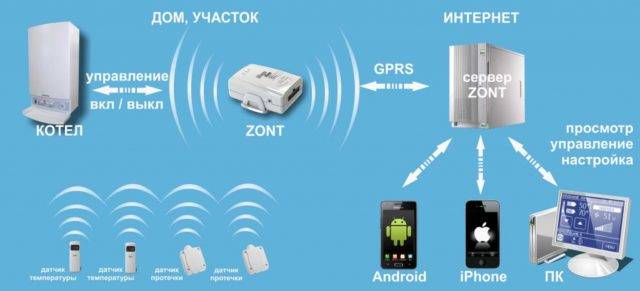

Management via the Internet is carried out in the same way, only through a different communication channel between the homeowner and the electronic unit in the house.
- remote communication between components using radio transmitters;
- the operation of radiators (depending on the settings) can be in a comfortable, normal or economic mode;
- the number of connected circuits can be increased by connecting additional modules;
- heating control by mobile phone;
- data transfer via SMS, etc.
These functional features make the presented elements quite convenient and in demand.
Zone devices
Such heating control elements are installed directly on radiators and boilers. In this case, the regulation by the system is carried out via the Internet connection. These devices are represented by electronic thermostats. They are able to change the temperature of the water in each individual battery or system as a whole. The differences between these thermostats are ease of installation and affordable price. At the same time, the complexity of the system device is reduced, especially since they do not require a separate control cabinet. Zone devices allow the use of several thermostats that are connected to one control unit.
Remote heating control modules
The function of remote control of the heating network can be provided by special modules included in the package with shut-off and control valves and programmers.
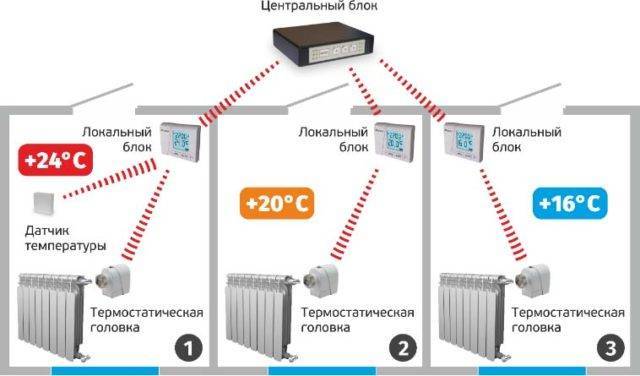

The number of additional device functions is limited by the number of connected sensors and executive relays of the electronic heating control unit itself
Organization of heating control


On the western market, the choice of programmers and controllers is greater - but they usually do not have Russian localization.
The thermal conductivity of ceilings, partitions and walls, the quality of insulation in them, the implemented heating system and the method of heat distribution are all components of the climate inside the building. Radiators, warm floors, boilers, boilers play an important role here - this can be controlled with a single control unit.
Controllers and programmers help to customize the operation of any systems included in the "smart home", and not just control home heating. Communication between all systems occurs through local blocks and executive relays, and their operation is monitored using sensors.
All components, in turn, are connected and configured in the main control unit. The list of systems that can be connected depends on the model and functionality of the latter.
